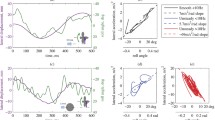Abstract
Aerodynamic forces and power requirements in forward flight in a bumblebee (Bombus terrestris) were studied using the method of computational fluid dynamics. Actual wing kinematic data of free flight were used in the study (the speed ranges from 0 m/s to 4.5 m/s; advance ratio ranges from 0–0.66). The bumblebee employs the delayed stall mechanism and the fast pitching-up rotation mechanism to produce vertical force and thrust. The leading-edge vortex does not shed in the translatory phase of the half-strokes and is much more concentrated than that of the fruit fly in a previous study. At hovering and low-speed flight, the vertical force is produced by both the half-strokes and is contributed by wing lift; at medium and high speeds, the vertical force is mainly produced during the downstroke and is contributed by both wing lift and wing drag. At all speeds the thrust is mainly produced in the upstroke and is contributed by wing drag. The power requirement at low to medium speeds is not very different from that of hovering and is relatively large at the highest speed (advance ratio 0.66), i.e. the power curve is J-shaped. Except at the highest flight speed, storing energy elastically can save power up to 20%–30%. At the highest speed, because of the large increase of aerodynamic torque and the slight decrease of inertial torque (due to the smaller stroke amplitude and stroke frequency used), the power requirement is dominated by aerodynamic power and the effect of elastic storage of energy on power requirement is limited.
Similar content being viewed by others
References
Ellington, C.P.: The aerodynamics of hovering insect flight. IV. Aerodynamic mechanisms. Phil. Trans. R. Soc. Lond. B 305, 79–113 (1984)
Ellington, C.P.: The aerodynamics of hovering insect flight. VI. Lift and power requirements. Phil. Trans. R. Soc. Lond. B 305, 145–181 (1984)
Dudley, R., Ellington, C.P.: Mechanics of forward flight in bumblebees. II. Quasi–steady lift and power requirements. J. Exp. Biol. 148, 53–88 (1990)
Willmott, A.P., Ellington, C.P.: The mechanics of flight in the hawkmoth Manduca sexta. II. Aerodynamic consequences of kinematic and morphological variation. J. Exp. Biol. 200, 2723–2745 (1997)
Dickinson, M.H., Götz, K.G.: Unsteady aerodynamic performance of model wings at low Reynolds numbers. J. Exp. Biol. 174, 45–64 (1993)
Dickinson, M.H., Lehman, F.O., Sane, S.P.: Wing rotation and the aerodynamic basis of insect flight. Science 284, 1954–1960 (1999)
Wang, Z.J.: Two dimensional mechanism for insect hovering. Physical Rev. Lett. 85, 2216–2219 (2000)
Usherwood, J.R., Ellington, C.P.: The aerodynamics of revolving wings. I. Model hawkmoth wings. J. Exp. Biol. 205, 1547–1564 (2002)
Usherwood, J.R., Ellington, C.P.: The aerodynamics of revolving wings. II. Propeller force coefficients from mayfly to quail. J Exp Biol. 205, 1565–1576 (2002)
Sun, M., Tang, J.: Unsteady aerodynamic force generation by a model fruit fly wing in flapping motion. J. Exp. Biol. 205, 55–70 (2002)
Sane, S.P., Dickinson, M.H.: The control of flight force by a flapping wing: lift and drag production. J. Exp. Biol. 204, 2607–2626 (2001)
Sun, M., Tang, J.: Lift and power requirements of hovering flight in Drosophila. J. Exp. Biol. 205, 2413–2427 (2002)
Sun, M., Du, G.: Lift and power requirements of hovering insect flight. Acta Mech. Sinica. 19, 458–469 (2003)
Sun, M., Lan, S.L.: A computational study of the aerodynamic forces and power requirements of dragonfly (Aeschnajuncea) hovering. J. Exp. Biol. 207, 1887–1901 (2004)
Sun, M., Wu, J.H.: Aerodynamic force generation and power requirements in forward flight in a fruit fly with modeled wing motion. J. Exp. Biol. 206, 3065–3083 (2003)
Dudley, R., Ellington, C.P.: Mechanics of forward flight in bumblebees. I. Kinematics and morphology. J. Exp. Biol. 148, 19–52 (1990)
Ellington, C.P.: The aerodynamics of hovering insect flight. II. Morphological parameters. Phil. Trans. R. Soc. Lond. B 305, 17–40 (1984)
Wu, J.H., Sun, M.: Unsteady aerodynamic forces of a flapping wing. J. Exp. Biol., 207, 1137–1150 (2004)
Weis-fogh T.: Quick estimates of flight fitness in hovering animals, including novel mechanism for lift production. J. Exp. Biol. 59, 169–230 (1973)
Dudley, R.: The Biomechanics of Insect Flight: Form, Function, Evolution. Princeton University Press, Princeton, 2002
Author information
Authors and Affiliations
Corresponding author
Additional information
The project supported by the National Natural Science Foundation of China (10232010) and the National Aeronautic Science fund of China (03A51049)
The English text was polished by Xing Zhang.
Rights and permissions
About this article
Cite this article
Wu, J., Sun, M. Unsteady aerodynamic forces and power requirements of a bumblebee in forward flight. ACTA MECH SINICA 21, 207–217 (2005). https://doi.org/10.1007/s10409-005-0039-5
Received:
Revised:
Accepted:
Published:
Issue Date:
DOI: https://doi.org/10.1007/s10409-005-0039-5




